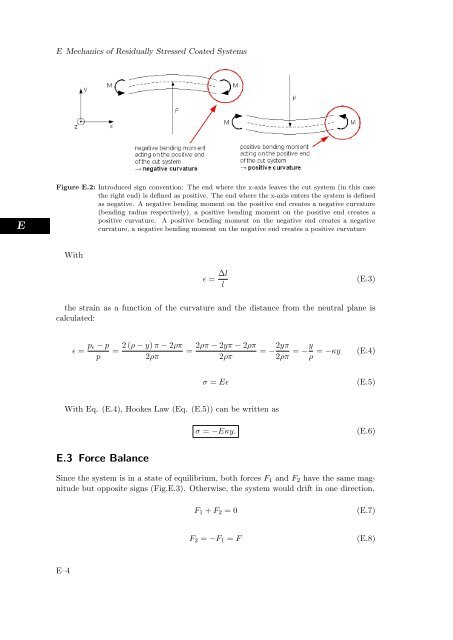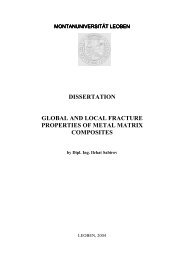1 - Erich Schmid Institute
1 - Erich Schmid Institute
1 - Erich Schmid Institute
You also want an ePaper? Increase the reach of your titles
YUMPU automatically turns print PDFs into web optimized ePapers that Google loves.
E<br />
E Mechanics of Residually Stressed Coated Systems<br />
Figure E.2: Introduced sign convention: The end where the x-axis leaves the cut system (in this case<br />
the right end) is defined as positive. The end where the x-axis enters the system is defined<br />
as negative. A negative bending moment on the positive end creates a negative curvature<br />
(bending radius respectively), a positive bending moment on the positive end creates a<br />
positive curvature. A positive bending moment on the negative end creates a negative<br />
curvature, a negative bending moment on the negative end creates a positive curvature<br />
With<br />
ɛ = ∆l<br />
l<br />
(E.3)<br />
the strain as a function of the curvature and the distance from the neutral plane is<br />
calculated:<br />
ɛ = pɛ − p<br />
p<br />
= 2 (ρ − y) π − 2ρπ<br />
2ρπ<br />
= 2ρπ − 2yπ − 2ρπ<br />
2ρπ<br />
= − 2yπ<br />
2ρπ<br />
With Eq. (E.4), Hookes Law (Eq. (E.5)) can be written as<br />
E.3 Force Balance<br />
= −y = −κy (E.4)<br />
ρ<br />
σ = Eɛ (E.5)<br />
σ = −Eκy. (E.6)<br />
Since the system is in a state of equilibrium, both forces F1 and F2 have the same magnitude<br />
but opposite signs (Fig.E.3). Otherwise, the system would drift in one direction.<br />
E–4<br />
F1 + F2 = 0 (E.7)<br />
F2 = −F1 = F (E.8)
















